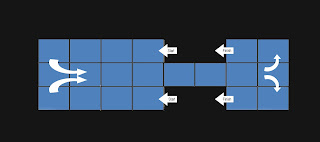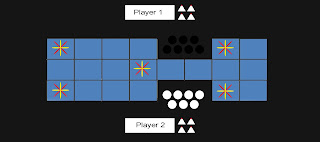Royal Game of Ur
The Royal Game of Ur was excavated from the Royal Cemetery of Ur by Sir Leonard Woolley between 1926 -1930. The tombs at Ur date from around 2,600BC which are located in southern Iraq.
The board is best described as sections with a larger body of squares (4x3) and a smaller body of squares (2x3) joined by a narrow neck with 2 squares in it (2x1).
This board type is recognized as the 3rd millennium BC version, the original version that all the later are based upon. Over time the game has changed shape but kept its fundamental race mechanic and rule set.
This version is the second millennium BC version. but by straightening out the smaller body of squares (2x3) into a straight line it changed the game into a more aggressive and faster game. but still keeping the basic rules and mechanics as the original.
For this blog post I'll be using the original first millennium BC board as means to explain the rules and how they work with one another. I wanted to introduce you to the board first so you would see how it worked visually as I talked about it because sometimes trying to in-vision the game itself around the rules is very difficult, especially when the rules are complex and there may be multiple pieces involved during play.
The game is played by 2 persons, each controlling there own pieces around the board. The original game had white and black pieces (7 of each), each player would control a colour. For the sake of simplify this a little I'll refer to these as "units"
To determine how many squares you move we use four 4-sided dice or "d4". Each d4 has two marked corners and you will roll all four at the same time. The result of the rolls are how many of the marked corners are faced up added together.
We enter our units into the board from the lower right square of the larger body from this point of view or from the bottom left from the opposite point of view (see picture below) as the first square. Each player starts on opposite sides of the board. Once you have made your way into the board you have to share the middle lane and neck of the board with your opponent.
Now we have a means to move and the units we move around the board we need to understand how the pieces interact with the board and the board with them. I'll begin with the Rosette squares. There are 5 rosette squares on the board placed 2 in the larger body, 1 along the neck and 2 on the smaller body. When you land on these squares you are granted an extra turn as reward. They have always been called rosette squares despite all the changes through the years and I thought I would keep that tradition with my board here.
You are also aloud more than one unit on the board at a time. So in essence you are able to have as many units on the board as you like but they cannot inhabit the same square as each other. When you have rolled and you can choice which unit you wish to move. This includes moving a new unit onto the board.
The next mechanic we are introduced to is the capturing of your opponents pieces. If for instance your opponent has a unit 3 squares ahead of yours and you rolled a 3 you would land on the same square as them. In the event of this happening you would capture their unit which would mean that this unit will be returned to the player and would have to start from the beginning again. This can only happen in the middle lane of squares.
The last mechanic which is common among these types of games is the need to get the exact number to move the units off the board via the exit / finish. So if you are on the last rosette you will need to roll a 1 to exit or maybe if your on the first square entering the smaller body of squares you would need to roll a 4 to exit. the last square is not the exit but 1 over that square taking you off the board.
The end goal of the game is to get all of your 7 units through the board first.
A Brief History of Ur
- Excavated from the Royal Cemetery of Ur by Sir Leonard Woolley between 1926 -1930
- The rules (written on tablet) were excavated in 1880 but unrecognized as this till 1956
- The clay tablet is the oldest known set of game rules in the world (dated 177bc)
- Has also been referred to as "the Game of 20 Squares" in various forms (you can guess why)
- The Second millennium version was played with only 5 units (original was 7)
- The Second millennium version was referred to as "Pack of Dogs"
- Throwing stick were also found at the excavation at Ur. Thought to be used as a type of dice
Tactics & Game Play
Given the fact this game was made sometime around 2600bc the mechanics within the game are very in-depth and bring about a lot of tactical play by means of the dice rolls and which unit you move depending on your roll, how many squares there are, sharing the middle lane, taking of opponent pieces, having more than one piece each on the board at any given time and the rosette squares.
For example if you rolled and you could move a unit in front of your opponents unit you had to way up the odds / chance of them rolling the number needed to land on your unit (See Dice Diagram) or maybe this is the plan as you have a unit behind that would be 2 squares behind theirs if they got so lucky therefor putting one of your units in harms way to get rid of one of theirs.
By far the safest way to play is to not put your units ahead of your opponents but that wont win you the game. Your forced by the need to achieve the win to be more aggressive and tactical in your approach towards the game. The best tactic I can think of is to get each unit through the board as fast as possible before you bring another one one.
Its easy to see why this game has been labeled as so many different types as it includes so many different dynamics.
Different Types
Theres many different iterations to the game which is understandable since the game is so old. There are a few iterations I enjoy and understand why they would be into the game. Here just some of the changes that have been made to different types of the game.
- Having to go around the last smaller body of squares (not doing directly down on the last in the middle lane sqaure)
- Making rosette squares safe zones (units on rosette squares cannot be captured)
- Changing the shape of the board itself but keeping the same rules
- Different amount of units
- Different amount of dice rolls
- Not needing the exact number to exit
- Needing to roll a certain number to enter a new unit






thanks for the info
ReplyDelete